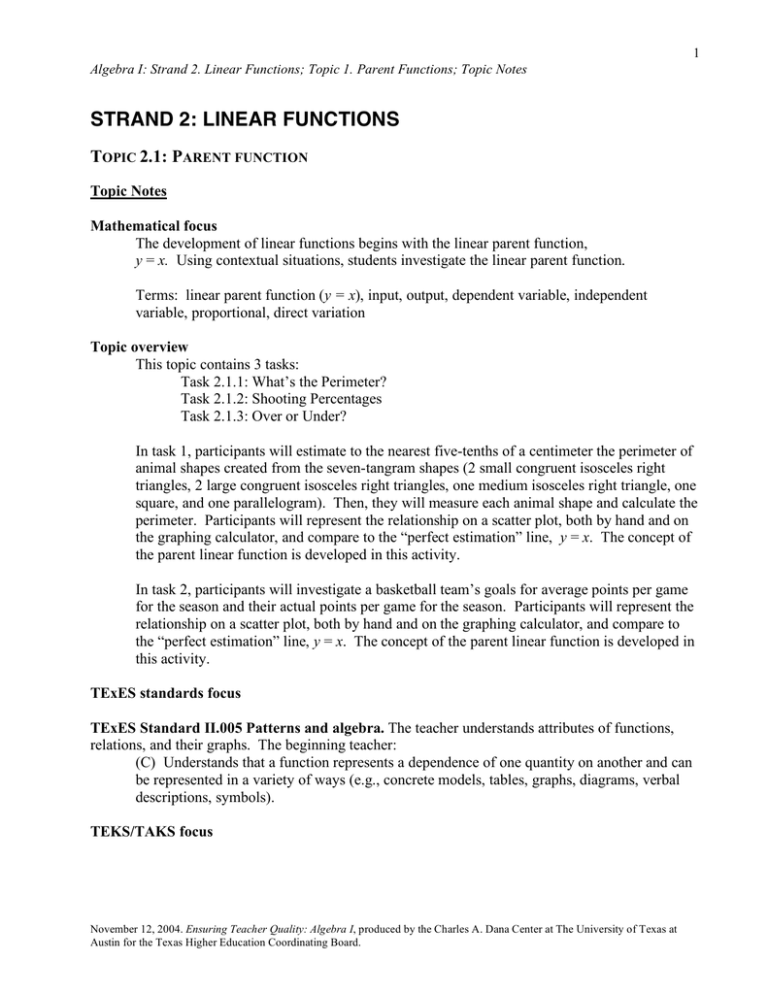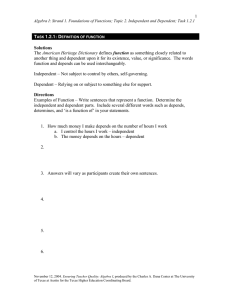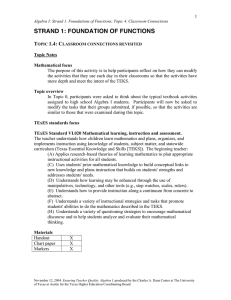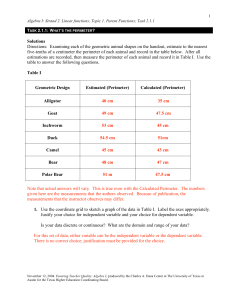STRAND 2: LINEAR FUNCTIONS T 2.1: P
advertisement

1 Algebra I: Strand 2. Linear Functions; Topic 1. Parent Functions; Topic Notes STRAND 2: LINEAR FUNCTIONS TOPIC 2.1: PARENT FUNCTION Topic Notes Mathematical focus The development of linear functions begins with the linear parent function, y = x. Using contextual situations, students investigate the linear parent function. Terms: linear parent function (y = x), input, output, dependent variable, independent variable, proportional, direct variation Topic overview This topic contains 3 tasks: Task 2.1.1: What’s the Perimeter? Task 2.1.2: Shooting Percentages Task 2.1.3: Over or Under? In task 1, participants will estimate to the nearest five-tenths of a centimeter the perimeter of animal shapes created from the seven-tangram shapes (2 small congruent isosceles right triangles, 2 large congruent isosceles right triangles, one medium isosceles right triangle, one square, and one parallelogram). Then, they will measure each animal shape and calculate the perimeter. Participants will represent the relationship on a scatter plot, both by hand and on the graphing calculator, and compare to the “perfect estimation” line, y = x. The concept of the parent linear function is developed in this activity. In task 2, participants will investigate a basketball team’s goals for average points per game for the season and their actual points per game for the season. Participants will represent the relationship on a scatter plot, both by hand and on the graphing calculator, and compare to the “perfect estimation” line, y = x. The concept of the parent linear function is developed in this activity. TExES standards focus TExES Standard II.005 Patterns and algebra. The teacher understands attributes of functions, relations, and their graphs. The beginning teacher: (C) Understands that a function represents a dependence of one quantity on another and can be represented in a variety of ways (e.g., concrete models, tables, graphs, diagrams, verbal descriptions, symbols). TEKS/TAKS focus November 12, 2004. Ensuring Teacher Quality: Algebra I, produced by the Charles A. Dana Center at The University of Texas at Austin for the Texas Higher Education Coordinating Board. 2 Algebra I: Strand 2. Linear Functions; Topic 1. Parent Functions; Topic Notes TEKS A.1 Foundations for functions. The student understands that a function represents a dependence of one quantity on another and can be described in a variety of ways. The student is expected to: (A) describe independent and dependent quantities in functional relationships; and (E) interpret and make decisions, predictions, and critical judgments from functional relationships. High School TAKS Objective 1: The student will describe functional relationships in a variety of ways. TEKS A.2 Foundations for functions. The student uses the properties and attributes of functions. The student is expected to: (A) identify and sketch the general forms of linear (y = x) and quadratic (y = x2) parent functions; (C) interpret situations in terms of given graphs or create situations that fit given graphs; and (D) collect and organize data, make and interpret scatter plots (including recognizing positive, negative, or no correlation for data approximating linear situations), and model, predict, and make decisions and critical judgments in problem situations. High School TAKS Objective 2: The student will demonstrate an understanding of the properties and attributes of functions. TEKS A.5 Linear functions. The student understands that linear functions can be represented in different ways and translates among their various representations. The student is expected to: (A) determine whether or not given situations can be represented by linear functions; (C) use, translate, and make connections among algebraic, tabular, graphical, or verbal descriptions of linear functions; and (G) relate direct variation to linear functions and solves problems involving proportional change. High School TAKS Objective 3: The student will demonstrate an understanding of linear functions. Materials TASK Geometric Animal Shapes What’s the Perimeter? Shooting Percentages Over and Under Map pencils Graphing calculator Graph paper #1 x x #2 #3 x x x x x x x x Procedure Task 2.1.1: Work begins with the linear function using contextual situations to develop intuitive notions about the line y = x. Arrange participants in groups of 3 to 4. Distribute to each participant one copy of the Geometric Animal Shapes handout and What’s the Perimeter? handout. November 12, 2004. Ensuring Teacher Quality: Algebra I, produced by the Charles A. Dana Center at The University of Texas at Austin for the Texas Higher Education Coordinating Board. 3 Algebra I: Strand 2. Linear Functions; Topic 1. Parent Functions; Topic Notes Participants estimate to the nearest five-tenths of a centimeter the perimeter of each Geometric Shapes Animal and record in appropriate column of Table I. For class discussion, recommend that Table I and the graph be on chart paper. Check that the line participants sketched, as their “perfect estimate” line, is indeed the line y = x. Ask participants to create a scatter plot (estimate, calculated) using the graphing calculator. Complete question 3-5. Task 2.1.2: Work begins with the linear function using contextual situations to develop intuitive notions about the line y = x. Arrange participants in groups of 3 to 4. Distribute to each participant one copy of the Shooting Percentages handout. Check that the line participants sketched, as their “perfect estimate” line, is indeed the line y = x. Ask participants to create a scatter plot (estimate, calculated) using the graphing calculator. Complete question 3-5. Task 2.1.3: Complete the task based on the given graphs. Summary After completing this topic, participants will have a better understanding of dependent and independent quantities, the parent function y=x, and applications of the statements y > x or y < x. Extensions These tasks also provide a review of the measurement concept of perimeter. They also build skill and understanding of using underlying processes and mathematical tools to solve problems (TAKS Objective 10). TEXTEAMS Algebra 2000 and Beyond – The Parent Function is a specific example of an extension activity for this task. Assessment/Transition to the classroom Participants should complete the Teacher’s Journal, recording their responses and making any modifications necessary to make the tasks completely classroom ready. November 12, 2004. Ensuring Teacher Quality: Algebra I, produced by the Charles A. Dana Center at The University of Texas at Austin for the Texas Higher Education Coordinating Board. 4 Algebra I: Strand 2. Linear Functions; Topic 1. Parent Functions; Topic Notes November 12, 2004. Ensuring Teacher Quality: Algebra I, produced by the Charles A. Dana Center at The University of Texas at Austin for the Texas Higher Education Coordinating Board.


